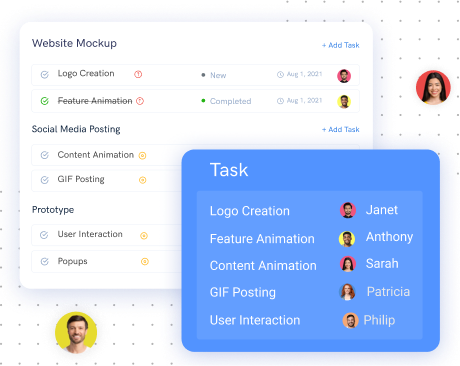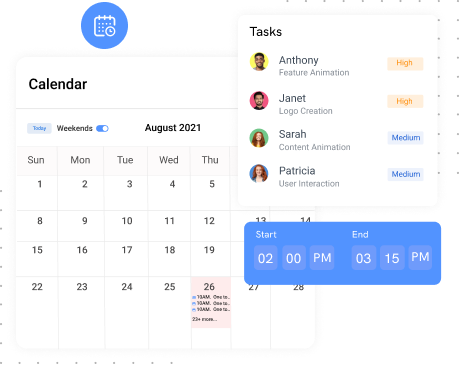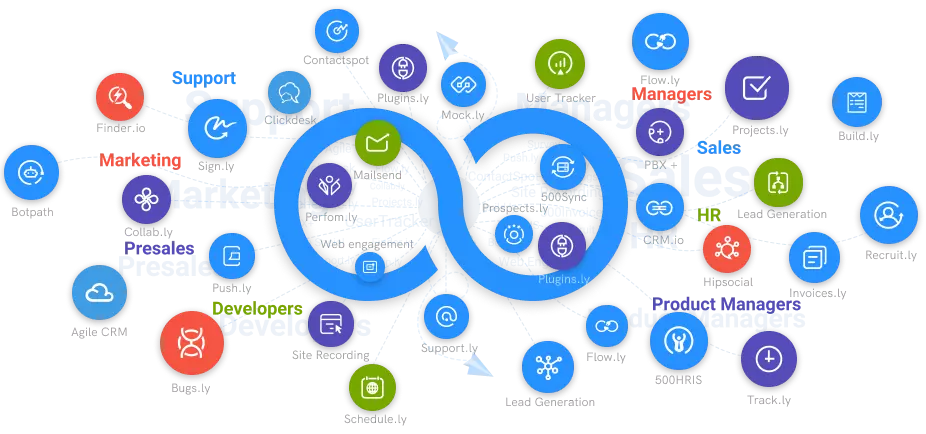What is a Project Design?
Get to know about project design in project management and what is its structure.
#1
Plan, organize, track all your projects in one place
#2
Get a visibility over individual tasks in the form of kanban boards
#3
Track the project schedule using gantt chart and calendar view
#4
Create advanced workflows with powerful automations
#5
Track employee activities, and working hours using built-in time tracking software, Clockly
#6
Monitor activities using screen recorder on Windows, Mac and Linux devices
#7
Set S.M.A.R.T goals and achieve results
#8
Share files and collaborate with team through discussion boards
#9
Unbelievable pricing - the lowest you will ever find
#10
Everything your business needs - 50 apps, 24/5 support and 99.95% uptime
The first step toward a successful project is to design it. A project design is a method of organising ideas, materials, and processes in order to achieve a specific goal. Project managers rely on smart design to avoid mistakes and offer parameters to keep key components of the project, such as the Project Timeline and budget, on track.
Some people make the mistake of rushing through the basic stages of a project, such as a Project Design. Any seasoned project manager will tell you that the more effort you put into the front-end of a project, the better the backend results will be.

One of the initial roles of the project manager is to design the project. Decisions regarding how to administer and govern the project are made at this point. A project plan is developed, focusing on the needs of the stakeholders, the organisation, and, of course, the project itself. This document will thereafter be used to oversee the project's remaining stages.
The thinking that occurs during Project Design, on the other hand, is less concerned with minutiae and more concerned with Project Management. Project management software can aid in the organisation of both the high-level strategy and the finer points of a project's design.
The following entities make up a general Project Design:
- A detailed description of the organisation or corporation that will be responsible for the project's development.
- A detailed overview of the project, its origins, and how it should be developed
- The project's objectives, milestones, goals, and outcomes are listed down.
- It covers every product, significant deliverables, evaluation and monitoring standards, and success criterion characteristics.
- Finally, it discusses the budget estimating criteria and principles.
Streamline and improve transparency with a project management system to accomplish projects faster.
Structure of Project Design
There are processes to defining projects and building a plan for implementation. They are the most crucial steps in a project's development. As a result, you should include your team and stakeholders in the process to ensure that you've covered all of your bases. Take your time to finish this stage completely.
1. Define the Vision
This isn't some wishful thinking, but a vision statement that depicts an issue that needs to be solved. This entails defining the project's purpose. The vision statement is a formal document that outlines the project's possibilities. It is provided to stakeholders to demonstrate the project's viability and benefits.
It isn't a lengthy, in-depth paper. You can have a brief, utopian vision for the project's outcome; after all, this is how you sell the project. As a result, construct a picture of the project's success and set it in context.
2. Understand the Problem
You must first identify a problem that has to be solved in order to support that vision paper. As a result, a needs assessment is frequently required so that you can see the challenges that the company is facing. This will bring the problem you're working on into line with the organization's overall plan. It will also give you the information you need to come up with the best solution to the situation.
To begin, what data are you collecting? What sources do you have for such knowledge, and how will you go about gathering it? Next, examine and identify the issues that your project is intended to address. Organize your findings in a document.
3. Plan the Resources
The next step is to identify the resources required to complete the project. People, equipment, and facilities are all examples of resources needed to perform a project successfully.
The same way journalists tackle a news storey, using the Five W's: who, what, where, when, and why, is an excellent technique to figure out the resources. What resources are necessary to complete the project, what resource management tools are required, where will the work be completed, when will the project begin and end, and why are these resources required?
4. Define Project Goals
You won't be able to reach your objectives until you first identify them. A goal is something that can be seen and measured at the end of a project. A goal is the same as a solution to a problem.
Make a goal statement that explains how the project's objectives are met. Use the SMART method, which stands for specific, measurable, achievable, realistic, and time-relevant, to achieve this well. These terms should be used to define each goal.

5. Propose Project Strategy
A strategy must be in place to achieve the project's objectives. A strategy is a method for achieving the project's objectives while staying within the project's restrictions, such as resources, schedule, and budget. How can a plan be developed to meet the project's objectives?
Consider precedent and look back on similar projects in the past to see what they may have revealed about the benefits and drawbacks of their chosen tactics. Best Project Management practises are always a sound foundation, and then incrementally create a plan, creating a route to success.
6. Build Contingency Plan
Few things go according to plan, as any project manager knows. There must be a backup plan in place to respond swiftly and correctly to concerns that develop throughout the course of a project. As a result, this must be considered when planning your project.
Keep an eye out for the project's unfavourable hazards. They are immersed in a variety of settings, including teams that may be lacking in skills, have unavoidable absences, turnover, and so on. Delays may wreak havoc on schedules. It's possible that the scope was not clearly established. Costs are understated, or funds become scarce. Make a plan to deal with these dangers.
7. Create Proper Budget
The budget lays forth the financial resources needed to complete the project. Each of the project criteria will be assigned a cost in a budget. Creating a project budget entails formally allocating financial resources to the project. This starts with deciding on a method for estimating costs, identifying impacts, and reporting on the evaluation.
8. Provide Project Proposal
All of this culminates in a project proposal that explains why the project should be carried out and what benefits it would provide. The previous steps are summarised by putting up the project's goal and a concise description of the issue it addresses. Then, identify the project's objectives and the method that will be employed to attain them.
Conclusion
You can think how difficult and important it is for the structure of the Project Design itself to be tough and important if the entire development process and the success of the project depend on it. A Project Design helps you eliminate any obstacles in the project development process and reduces any confusion about the project vision among everyone involved in the project.
Projectsly is one of the best task management software that lets you create Project Design and leads you to successful project completion.





